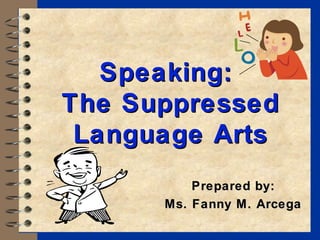Signaler
Partager

Recommandé
Contenu connexe
Tendances
Tendances (19)
Sociolinguistics Intercultural Communication in a Multilingual World

Sociolinguistics Intercultural Communication in a Multilingual World
Cross cultural communication-translating nonverbal cues

Cross cultural communication-translating nonverbal cues
Effective communication using johari windows by MVS Rao

Effective communication using johari windows by MVS Rao
Similaire à Speaking
Similaire à Speaking (20)
Head-to-Toe AssessmentNSG3012 Week 4 ProjectSystemFindings.docx

Head-to-Toe AssessmentNSG3012 Week 4 ProjectSystemFindings.docx
Session-8_OASAS_CulturalCompetenceTraining_Racism_Oppression.pptx

Session-8_OASAS_CulturalCompetenceTraining_Racism_Oppression.pptx
Speaking
- 1. Speaking:Speaking: The SuppressedThe Suppressed Language ArtsLanguage Arts Prepared by:Prepared by: Ms. Fanny M. ArcegaMs. Fanny M. Arcega
- 2. To know the nature and value ofTo know the nature and value of speakingspeaking To recognize the different types ofTo recognize the different types of speakerspeaker To understand the reasons why it isTo understand the reasons why it is considered as the suppressedconsidered as the suppressed language artslanguage arts ObjectivesObjectives What is speaking? Why is it important to you?
- 3. Language ArtsLanguage Arts Reading Writing SuppressedSuppressed Kept from public knowledge by various means Manifesting or subjected to suppression SpeakingSpeaking Is an act of making vocal sounds Communicating ideas through oral language Listening Speaking
- 4. Speaking It is an expressive language skill in which the speaker uses verbal symbols to communicate. Types of Speaker The Non- Speaker/ Avoider The Occasional Speaker/ Resister The Willing Speaker/ Accepter The Leader/ Seeker There are three kinds of speaking situations in which we find ourselves: Interactive partially interactive Non-interactive
- 5. When was the last time you exercised your freedom of expression? Abolition of PDAF (Priority Development Assistant Fund) Group 1: What does Freedom of Expression mean to you? Why does it matter? Group 2: What are the limitations of Freedom of Expression?
- 6. Freedom of ExpressionFreedom of Expression “Everyone has the right to freedom of opinion and expression; this right includes freedom to hold opinions without interference and to seek, receive and impart information and ideas through any media and regardless of frontiers”. (Article 19, Universal Declaration of Human Rights, 1948) It is not absolute It is a complex right
- 7. 4 Important Ways4 Important Ways It is essential for the search of truth Needed for democracy to work properly Securing the people’s participation in social and political decision Promotes self-realization and self- determination Freedom of expression contains two guarantees: Prohibiting prior restraint A prohibition of subsequent punishment
- 8. Do you think Freedom of expression should have its limitations? o Provided by lawProvided by law o ““Legitimate Aim”Legitimate Aim” o NecessityNecessity Limitations 2 Categories: 1.For respect of the rights or reputations of others 2.For the protection of national security, public order, public health or morals.
- 9. The clear and present danger rule - Speech present danger and imminent evil Hate or Violent speech • Speech that attacks a person or group on the basis of race, religion, gender, or sexual orientation Speaking become suppressed: - It goes beyond the limitations of freedom of expressions - If it hurts person’s feeling
